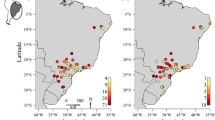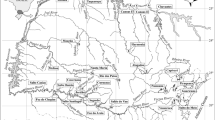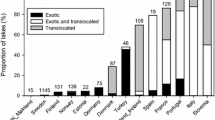Abstract
Several human activities may result in or facilitate species introductions. In aquatic environments, species introductions are often associated with the construction of dams. In this study, we use reservoirs of the Neotropical region as a model to determine the main causes of fish species introductions. We compiled information on non-native fish species present in reservoir ichthyofauna surveys in the past 14 years and classified these species based on their probable reason for introduction (vector). Fish farming activities introduced approximately 7.6-fold more species in reservoirs than the other vectors identified. The matrix of the number of fish species per vectors explained the greatest proportion of the composition of non-native assemblages, whereas the geographic distance and age of the reservoir explained few of these variations. The non-native ichthyofauna composition varied among Neotropical basins and can be explained by the different sets of species introduced by the companies managing the reservoirs. Although power companies have banned stocking with non-natives, fish farming in the Neotropical region continues to use non-native species, and these species are occupying water bodies, especially reservoirs.





Similar content being viewed by others
References
Abell, R., M. L. Thieme, C. Revenga, M. Bryer, M. Kottelat, N. Bogutskaya, B. Coad, N. Mandrak, S. C. Balderas, W. Bussing, M. L. J. Stiassny, P. Skelton, G. R. Allen, P. Unmack, A. Naseka, R. Ng, N. Sindorf, J. Robertson, E. Armijo, J. V. Higgins, T. J. Heibel, E. Wikramanayake, D. Olson, H. L. López, R. E. Reis, J. G. Lundberg, M. H. S. Pérez & P. Petry, 2008. Freshwater ecoregions of the world: a new map of biogeographic units for freshwater biodiversity conservation. BioScience 58: 403–414.
Agostinho, A. A., L. C. Gomes & F. M. Pelicice, 2007. Ecologia e manejo de recursos pesqueiros em reservatórios do Brasil. Eduem, Maringá.
Agostinho, A. A., F. M. Pelicice & L. C. Gomes, 2008. Dams and the fish fauna of the Neotropical region: impacts and management related to diversity and fisheries. Brazilian Journal of Biology 68: 1119–1132.
Agostinho, A. A., F. M. Pelicice, L. C. Gomes & H. F. Júlio Jr, 2010. Reservoir fish stocking: when one plus one may be less than two. Natureza & Conservação 8: 103–111.
Aigo, J., V. Cussac, S. Peris, S. Ortubay, S. Gómez, H. López, M. Gross, J. Barriga & M. Battini, 2008. Distribution of introduced and native fish in Patagonia (Argentina): patterns and changes in fish assemblages. Reviews in Fish Biology and Fisheries 18: 387–408.
Alberts, J. S. & R. E. Reis, 2011. Introduction to Neotropical freshwaters. In Alberts, J. S. & R. E. Reis (eds), Historical Biogeography of Neotropical Freshwater Fishes. University of California Press, Berkeley: 3–19.
Azevedo-Santos, V. M., O. Rigolin-Sá & F. M. Pelicice, 2011. Growing, losing or introducing? Cage aquaculture as a vector for the introduction of non-native fish in Furnas Reservoir, Minas Gerais, Brazil. Neotropical Ichthyology 9: 915–919.
Baiser, B., J. D. Olden, S. Record, J. L. Lockwood & M. L. McKinney, 2012. Pattern and process of biotic homogenization in the New Pangaea. Proceedings of the Royal Society Biological Sciences 279: 4772–4777.
Britton, J. R. & M. L. Orsi, 2012. Non-native fish in aquaculture and sport fishing in Brazil: economic benefits versus risks to fish diversity in the upper River Paraná Basin. Reviews in Fish Biology and Fisheries 22: 1–12.
Canonico, G. C., A. Arthington, J. K. McCrary & M. L. Thieme, 2005. The effects of introduced tilapias on native biodiversity. Aquatic Conservation: Marine and Freshwater Ecosystems 15: 463–483.
Casal, C. M. V., 2006. Global documentation of fish introductions: the growing crisis and recommendations for action. Biological Invasions 8: 3–11.
Clavero, M. & E. García-Berthou, 2005. Invasive species are a leading cause of animal extinctions. Trends in Ecology and Evolution 20: 110.
Clavero, M. & V. Hermoso, 2011. Reservoirs promote the taxonomic homogenization of fish communities within river basins. Biodiversity and Conservation 20: 41–57.
Clavero, M., V. Hermoso, E. Aparicio & F. N. Godinho, 2013. Biodiversity in heavily modified waterbodies: native and introduced fish in Iberian reservoirs. Freshwater Biology 58: 1190–1201.
Ehrenfeld, J. G., 2010. Ecosystem consequences of biological invasions. Annual Review of Ecology, Evolution, and Systematics 41: 59–80.
Ellender, B. R. & O. L. F. Weyl, 2014. A review of current knowledge, risk and ecological impacts associated with non-native freshwater fish introductions in South Africa. Aquatic Invasions 9: 117–132.
Elvira, B. & A. Almodóvar, 2001. Freshwater fish introductions in Spain: facts and figures at the beginning of the 21st century. Journal of Fish Biology 59: 323–331.
Espínola, L. A., C. V. Minte-Vera & H. F. Júlio Jr, 2010. Invasibility of reservoirs in the Paraná to Cichla kelberi Kullander and Ferreira, 2006. Biological Invasions 12: 1873–1888.
Ferreira, E. A., 2012. Mecanismos associados aos padrões de distribuição de peixes não nativos em reservatórios neotropicais. Universidade Estadual de Maringá. Thesis: 72 pp.
Finer, M. & C. N. Jenkins, 2012. Proliferation of hydroelectric dams in the Andean Amazon and implications for Andes-Amazon connectivity. Plos One 7: e35126.
Graça, W. J. & C. S. Pavanelli, 2007. Peixes da planície de inundação do Alto Rio Paraná e áreas adjacentes. Eduem, Maringá.
Hair, J. F., R. L. Tatham, R. E. Anderson & W. Black, 1998. Multivariate Data Analysis. Prentice-Hall, New Jersey.
Holčík, J., 1991. Fish introductions in Europe with particular reference to its Central and Eastern part. Canadian Journal of Fisheries and Aquatic Sciences 48: 13–23.
Johnson, P. T. J., J. D. Olden & M. J. V. Zanden, 2008. Dam invaders: impoundments facilitate biological invasions into freshwaters. Frontiers in Ecology and the Environment 6: 357–363.
Júlio Jr, H. F., C. D. Tós, A. A. Agostinho & C. S. Pavanelli, 2009. A massive invasion of fish species after eliminating a natural barrier in the upper rio Paraná basin. Neotropical Ichthyology 7: 709–718.
Kovalenko, K. E., E. D. Dibble, A. A. Agostinho, G. Cantanhêde & R. Fugi, 2010. Direct and indirect effects of an introduced piscivore, Cichla kelberi and their modification by aquatic plants. Hydrobiologia 638: 245–253.
Langeani, F., R. M. C. Castro, O. T. Oyakawa, O. A. Shibatta, C. S. Pavanelli & L. Cassatti, 2007. Diversidade da ictiofauna do Alto Rio Paraná: composição atual e perspectivas futuras. Biota Neotropica 7: 181–197.
Legendre, P. & L. Legendre, 1998. Numerical Ecology. Elsevier, Amsterdam.
Legendre, P., D. Bocard & P. R. Peres-Neto, 2005. Analyzing beta diversity: partitioning the spatial variation of community composition data. Ecological Monographs 75: 435–450.
Leprieur, F., O. Beauchard, S. Blanchet, T. Oberdorff & S. Brosse, 2008. Fish invasions in the world’s river systems: when natural processes are blurred by human activities. Plos One 6: e28.
Leprieur, F., J. D. Olden, S. Lek & S. Brosse, 2009. Contrasting patterns and mechanisms of spatial turnover for native and exotic freshwater fish in Europe. Journal of Biogeography 36: 1899–1912.
Lima, Jr., D. P., F. M. Pelicice, J. R. S. Vitule & A. A. Agostinho, 2012. Aquicultura, política e meio ambiente no Brasil: Novas propostas e velhos equívocos. Natureza & Conservação 10: 1–4.
Lockwood, J. L., P. Cassey & T. Blackburn, 2005. The role of propagule pressure in explaining species invasions. Trends in Ecology and Evolution 20: 223–228.
Lockwood, J. L., P. Cassey & T. M. Blackburn, 2009. The more you introduce the more you get: the role of colonization pressure and propagule pressure in invasion ecology. Diversity and Distributions 15: 904–910.
Maceda-Veiga, A., J. Escribano-Alacid, A. Sostoa & E. García-Berthou, 2013. The aquarium trade as a potential source of fish introductions in southwestern Europe. Biological Invasions 15: 2707–2716.
Magalhães, A. L. B. & C. M. Jacobi, 2013a. Asian aquarium fishes in a Neotropical biodiversity hotspot: impeding establishment, spread and impacts. Biological Invasions 15: 2157–2163.
Magalhães, A. L. B. & C. M. Jacobi, 2013b. Invasion risks posed by ornamental freshwater fish trade to southeastern Brazilian rivers. Neotropical Ichthyology 11: 433–441.
Naylor, R. L., S. L. Williams & D. R. Strong, 2001. Aquaculture – a gateway for exotic species. Science 294: 1655–1656.
Nekola, J. C. & P. S. White, 1999. The distance decay of similarity in biogeography and ecology. Journal of Biogeography 26: 867–878.
Oksanen, J., F. G. Blanchet, R. Kindt, P. Legendre, P. R. Minchin, R. B. O’Hara, G. L. Simpson, P. Solymos, M. H. M. Stevens & H. Wagner, 2013. vegan: Community Ecology Package. R Package Version 2.0-7. Available at: http://CRAN.R-project.org/package=vegan.
Orsi, M. L. & A. A. Agostinho, 1999. Introdução de espécies de peixes por escapes acidentais de tanques de cultivo em rios da Bacia do Rio Paraná, Brasil. Revista Brasileira de Zoologia 16: 557–560.
Palmer, M. W., 1993. Putting things in even better order: the advantages of Canonical Correspondence Analysis. Ecology 74: 2215–2230.
Pelicice, F. M. & A. A. Agostinho, 2009. Fish fauna destruction after the introduction of a non-native predator (Cichla kelberi) in a Neotropical reservoir. Biological Invasions 11: 1789–1801.
Pelicice, F. M., J. R. S. Vitule, D. P. Lima Jr, M. L. Orsi & A. A. Agostinho, 2014. A serious new threat to Brazilian freshwater ecosystems: the naturalization of nonnative fish by decree. Conservation Letters 7: 55–60.
Petesse, M. L. & M. Petrere Jr, 2012. Tendency towards homogenization in fish assemblages in the cascade reservoir system of the Tietê river basin, Brazil. Ecological Engineering 48: 109–116.
Poff, N. L., J. D. Olden, D. M. Merritt & D. M. Pepin, 2007. Homogenization of regional river dynamics by dams and global biodiversity implications. Proceedings of the National Academy of Sciences of the United States of America 104: 5732–5737.
Pringle, C. M., M. C. Freeman & B. J. Freeman, 2000. Regional effects of hydrologic alterations on riverine macrobiota in the new world: tropical–temperate comparisons. BioScience 50: 807–823.
R Core Team, 2013. R: A Language and Environment for Statistical Computing. R Foundation for Statistical Computing, Vienna.
Rahel, F. J., 2002. Homogenization of freshwater faunas. Annual Review of Ecology and Systematics 33: 291–315.
Reis, R. E., S. O. Kullander & C. J. Ferraris Jr, 2003. Check List of the Freshwater Fishes of South and Central America. Edipucrs, Porto Alegre.
Ricciardi, A., 2007. Are modern biological invasions an unprecedented form of global change? Conservation Biology 21: 329–336.
ter Braak, C. J. F. & P. F. M. Verdonschot, 1995. Canonical correspondence analysis and related multivariate methods in aquatic ecology. Aquatic Sciences 57: 255–289.
Vitousek, P. M., H. A. Mooney, J. Lubchenco & J. M. Melillo, 1997. Human domination of Earth’s ecosystems. Science 277: 494–499.
Vitule, J. R. S., F. Skóra & V. Abilhoa, 2012. Homogenization of freshwater fish faunas after the elimination of a natural barrier by a dam in Neotropics. Diversity and Distributions 18: 111–120.
Wallace, A. R., 1876. The Geographical Distribution of Animals: With a Study of the Relations of Living and Extinct Faunas as Elucidating the Past Changes of the Earth’s Surface. Harper & Brothers, New York.
Welch, B. L., 1951. On the comparison of several mean values: an alternative approach. Biometrika 38: 330–336.
Zambrano, L., E. Martínez-Meyer, N. Menezes & A. T. Peterson, 2006. Invasive potential of common carp (Cyprinus carpio) and Nile tilapia (Oreochromis niloticus) in American freshwater systems. Canadian Journal of Fisheries and Aquatic Sciences 63: 1903–1910.
Acknowledgements
We thank Msc. Anielly G. Oliveira and Msc. Larissa Strictar-Pereira for comments on an early version of the manuscript and to Msc. Fagner Souza and Msc. Gabriel Deprá for reviewing the species list. We also thank both the anonymous reviewers for comments that improved many aspects of this paper. J. C. G. Ortega thanks the Coordenação de Aperfeiçoamento de Pessoal de Nível Superior (CAPES) for a scholarship and the Programa de Excelência Acadêmica (Proex/CAPES) for additional funding. A. A. Agostinho and L. C. Gomes are researchers in Scientific Productivity at the Conselho Nacional de Desenvolvimento Científico e Tecnológico (CNPq) and acknowledge this agency for long-term provision of funds.
Author information
Authors and Affiliations
Corresponding author
Additional information
Guest editors: Sidinei M. Thomaz, Katya E. Kovalenko, John E. Havel & Lee B. Kats / Aquatic Invasive Species
Electronic supplementary material
Below is the link to the electronic supplementary material.
Rights and permissions
About this article
Cite this article
Ortega, J.C.G., Júlio, H.F., Gomes, L.C. et al. Fish farming as the main driver of fish introductions in Neotropical reservoirs. Hydrobiologia 746, 147–158 (2015). https://doi.org/10.1007/s10750-014-2025-z
Received:
Revised:
Accepted:
Published:
Issue Date:
DOI: https://doi.org/10.1007/s10750-014-2025-z




